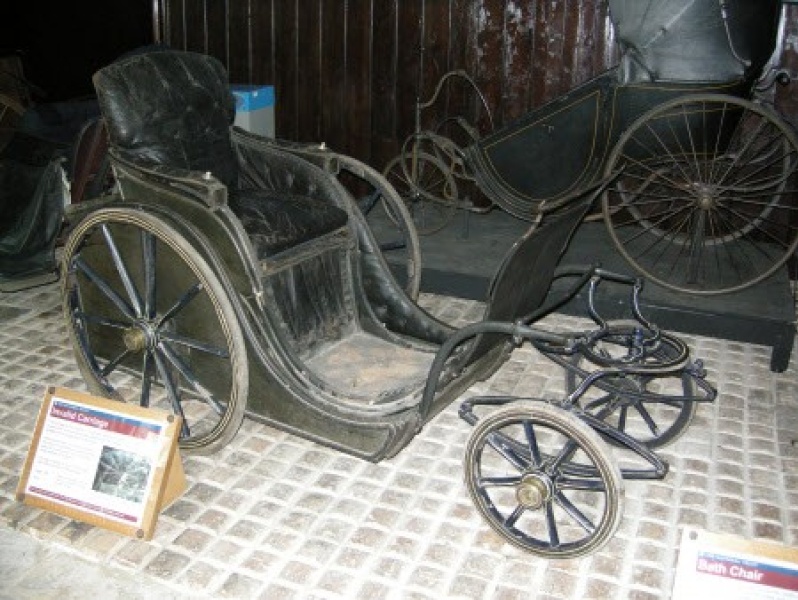Listed in 1 collection
Listed at 1 museum
Listed for 1 maker
Quick Details
Carriage Type
Invalid Carriage
Date of Production
late 19th century
Accession or Inventory Number
ARL/CM/W/2
Materials used
Paint, Wood, Iron, Leather, Wool Box Cloth, BrassSummary of Invalid Carriage
Built by J. Ward of Leicester Square, London, this carriage, painted in the colours of the 6th Marquis of Bute, would appear to have been specially built to accommodate an invalid chair, which can be wheeled into it up a hinged ramp at the back. The wheels are no longer fitted to the chair. A small pony, driven by the invalid, would draw the carriage. The wrought iron shafts are, unusually, in the shape of a wishbone.
Dimentions
body of the carriage
Height: 45 ins
Length: 83 ½ ins
Width: 48 ½ ins
Front wheel diameter: 18 ½ ins
Rear wheel diameter: 32 ¼ ins
Full description
This invalid carriage has a very low body with a straight bottom line that is only 7 ins above the ground. The tailboard is panelled with hinges at the bottom. The chair has a cut-under body and is of curved form with a hinged back rest, the angle of which can be controlled by two knobs. There are fittings for an adjustable footrest which is missing. With the wheels and axle removed the chair fits into the body of the carriage.
The wheels on the carriage are 8 and 10 spoke English pattern with solid rubber tyres. The wheels and axle of the chair are missing. The carriage has grease axles of a type peculiar to invalid carriages. The front axle compassed is up and the hind axle cranked down by approximately 10 ½ ins with brass axle caps. The carriage is sprung on elliptic springs in front with no springs behind.
The forecarriage is iron with a scrolled transom and a horn bar attached to curved stays from the front of the body. The axle bed reflects the shape of the transom. A lug is attached to the bottom wheel plate to carry the iron wishbone shafts (missing).
The body of the carriage is possibly painted dark blue but the colour is concealed beneath the decayed varnish. The wheels and forecarriage are in dark blue and lined with yellow. The chair has the same colour scheme with fine yellow lines. On the chair on both side panels is a monogram of CB beneath a Marquess coronet.
The inside surfaces of side panels are covered with padded and buttoned leather cloth with stitched seams in the shape of a wheel. The invalid chair has dark blue edging laces around all the inside edges. The chair has a leather dashboard with remains of leather serving on the mounting handles and the rein rail. Side squabs, arm rests and a seat rack are of buttoned dark brown morocco leather. The sprung seat cushion is upholstered in dark brown leather cloth and the seat fall is in dark brown morocco leather. Seaming and pasting laces are in dark blue wool cloth. The patterned floor cloth with a stencilled pattern is very deteriorated. Ivory knobs to attach an apron.
Inscriptions
On the axle caps: J.WARD*LEICESTER SQUARE * LONDON
On a label underneath the seat: By her majesties Royal letters Patent and by Royal Appointment To her Majesty and the Royal Family & to the Empress of Austria, Russia, France & ?
John Ward ?Leicester Square& 12 Leicester ? London Manufacturer of every kind of CHAIR, CARRIAGE, ANDBED For the Use & comfort of Invalids No. ? “Established more than a century”
Condition report
The invalid carriage is in original condition retaining its paintwork and leather upholstery.
Access information
This invalid carriage is in the care of The National Trust Carriage Museum at Arlington Court, Devon.
Arlington,
near Barnstaple,
Devon,
EX31 4LP
https://www.nationaltrust.org.uk/arlington-court-and-the-national-trust-carriage-museum
Picture credit
The National Trust/Elizabeth Jamieson

 Carriage Foundation
Carriage Foundation